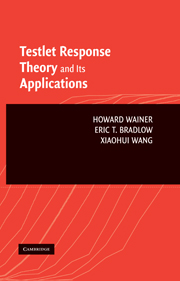Book contents
- Frontmatter
- Contents
- Preface
- PART I INTRODUCTION TO TESTLETS
- 1 Introduction
- 2 True score theory
- 3 Item response theory
- 4 What's a testlet and why do we need them?
- 5 The origins of testlet response theory – three alternatives
- 6 Fitting testlets with polytomous IRT models
- PART II BAYESIAN TESTLET RESPONSE THEORY
- PART III TWO APPLICATIONS AND A TUTORIAL
- Glossary of terms
- Epilogue
- Bibliography
- Author Index
- Subject Index
1 - Introduction
Published online by Cambridge University Press: 08 January 2010
- Frontmatter
- Contents
- Preface
- PART I INTRODUCTION TO TESTLETS
- 1 Introduction
- 2 True score theory
- 3 Item response theory
- 4 What's a testlet and why do we need them?
- 5 The origins of testlet response theory – three alternatives
- 6 Fitting testlets with polytomous IRT models
- PART II BAYESIAN TESTLET RESPONSE THEORY
- PART III TWO APPLICATIONS AND A TUTORIAL
- Glossary of terms
- Epilogue
- Bibliography
- Author Index
- Subject Index
Summary
To count is modern practice, the ancient method was to guess.
Samuel JohnsonThe subject of this book is testing. The origin of testing lies within a magical epiphany. Almost four thousand years ago, an anonymous functionary was focused on a task set before him by the emperor of China. He needed a procedure to choose wisely from among all applicants for government positions. Perhaps, utilizing a model made famous by Newton three millennia later, he was lying under a tree when the fundamental principle of testing struck him:
A small sample of behavior, gathered under controlled circumstances, can be predictive of performance in a much broader set of uncontrolled circumstances.
Testing is an ingenious solution to a practical problem. In an ideal world, before choosing among candidates for some position, we would like to know how they would perform in that position. Obviously, if we could place each of them in the position for a long enough period of time we would have direct evidence, but such a solution is usually not a practical possibility. But, even in a situation in which we had, say a year of trial, we would still not know for sure how they would perform after two years, or three, or more. In this instance, however, we would be pretty convinced of the validity of the task utilized to make the decision – it is, after all, the same job. But if the tasks on the job vary, the one-year trial period may not be long enough.
- Type
- Chapter
- Information
- Testlet Response Theory and Its Applications , pp. 3 - 13Publisher: Cambridge University PressPrint publication year: 2007
- 3
- Cited by



